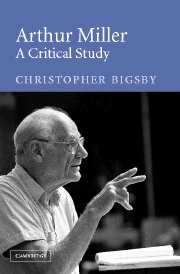Book contents
- Frontmatter
- Contents
- Acknowledgements
- Note on the text
- Introduction
- 1 The Michigan plays
- 2 The Golden Years, The Half-Bridge, Boro Hall Nocturne
- 3 The radio plays
- 4 The Man Who Had All the Luck
- 5 Focus
- 6 All My Sons
- 7 Death of a Salesman
- 8 Arthur Miller: time-traveller
- 9 An Enemy of the People
- 10 The Crucible
- 11 A Memory of Two Mondays
- 12 A View from the Bridge
- 13 Tragedy
- 14 The Misfits
- 15 After the Fall
- 16 Incident at Vichy
- 17 The Price
- 18 The Creation of the World and Other Business
- 19 The Archbishop's Ceiling
- 20 Playing for Time
- 21 The shearing point
- 22 The American Clock
- 23 The one-act plays: Two-Way Mirror, and Danger: Memory!
- 24 The Ride Down Mount Morgan
- 25 The Last Yankee
- 26 Broken Glass
- 27 Mr Peters' Connections
- 28 Resurrection Blues
- 29 Finishing the Picture
- 30 Fiction
- 31 Arthur Miller as a Jewish writer
- Notes
- Index
29 - Finishing the Picture
Published online by Cambridge University Press: 16 November 2009
- Frontmatter
- Contents
- Acknowledgements
- Note on the text
- Introduction
- 1 The Michigan plays
- 2 The Golden Years, The Half-Bridge, Boro Hall Nocturne
- 3 The radio plays
- 4 The Man Who Had All the Luck
- 5 Focus
- 6 All My Sons
- 7 Death of a Salesman
- 8 Arthur Miller: time-traveller
- 9 An Enemy of the People
- 10 The Crucible
- 11 A Memory of Two Mondays
- 12 A View from the Bridge
- 13 Tragedy
- 14 The Misfits
- 15 After the Fall
- 16 Incident at Vichy
- 17 The Price
- 18 The Creation of the World and Other Business
- 19 The Archbishop's Ceiling
- 20 Playing for Time
- 21 The shearing point
- 22 The American Clock
- 23 The one-act plays: Two-Way Mirror, and Danger: Memory!
- 24 The Ride Down Mount Morgan
- 25 The Last Yankee
- 26 Broken Glass
- 27 Mr Peters' Connections
- 28 Resurrection Blues
- 29 Finishing the Picture
- 30 Fiction
- 31 Arthur Miller as a Jewish writer
- Notes
- Index
Summary
Finishing the Picture, which Arthur Miller had first sketched out in 1977–8, is something more than a dramatisation of a struggle to finish a film, of the competing necessities, ambitions, psychological compulsions of a group of people who come together to serve art and commerce. It is a study of power and the price of creativity. It is an account of individual lives and a culture at risk of losing a sense of purpose and direction. It is a dramatisation of a life balanced between performance and being. What, after all, is real in a context of those who come together to construct a fiction, which nonetheless is designed to capture truth? As a character observes, ‘Life isn't real to movie people.’ Yet at the same time, as is said of Kitty, the damaged movie star at the centre of the play, ‘she's more real than people like us who live in the sunlight’.
Beyond the immediate action, which centres on whether a film can continue, over budget and with a star seemingly slipping into a private world, in an election year in which politicians are arguing over the future of the country and the sky is lit by flames, there is more than a hint of apocalypse. There are decisions to be made not only here on the location of a film but also in a society poised between its own utopian myths and the pragmatics of the material world.
- Type
- Chapter
- Information
- Arthur MillerA Critical Study, pp. 437 - 443Publisher: Cambridge University PressPrint publication year: 2004



